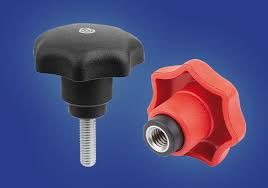Machine ergonomics play a critical role in creating efficient, comfortable, and safe work environments. One of the most overlooked aspects of ergonomics in machinery is the use of appropriate handles and knobs that facilitate ease of operation and minimise the risk of injury. Particularly, Kipp ball knobs have emerged as a crucial component in enhancing the functionality and ergonomic viability of equipment.
Understanding the Importance of Ergonomic Equipment Design
At the heart of machine ergonomics lies the principle of designing equipment that complements the natural movements of the human body. When machines are designed with ergonomics in mind, they not only promote user comfort but also improve productivity and efficiency. Ergonomic design takes into account factors such as the user’s posture, repetitive movements, and the force required to operate machinery.
The Evolution of Machine Operation Interfaces
Machine interfaces, including handles, grips, and knobs, have evolved considerably over the years to meet ergonomic standards. Originally, these components were designed with a one-size-fits-all approach, often resulting in discomfort and a higher incidence of musculoskeletal disorders for operators. Today, the design of these components is primarily user-centric, focusing on reducing strain and fatigue during operation.
Role of Kipp Ball Knobs in Ergonomic Design
Among the various types of handles and knobs available, Kipp ball knobs are highly regarded for their contributions to ergonomic machinery design. These knobs are meticulously crafted to provide a comfortable grip and to enhance user control over machinery. Their spherical shape allows for natural alignment with the palm, reducing the risk of strain during repetitive tasks.
Manufacturers are consistently looking for ways to enhance equipment functionality, and integrating Kipp ball knobs is a testament to the commitment to ergonomic excellence. Unlike traditional knobs, which may have sharp edges or inadequate grip surfaces, Kipp ball knobs are user-friendly, allowing for prolonged use without discomfort.
The Material Advantage
Another significant advantage of Kipp ball knobs is the variety of materials they are available in. Depending upon the application, these knobs can be found in hard-wearing thermoplastics, durable metals, and even specialised materials that can withstand extreme conditions.
The selection of material also impacts the ergonomic aspect, as it can affect the weight and thermal properties of the knob, influencing the user’s comfort level.
READ MORE : Making Your Website AI-Ready: A Business Essential in 2025
The Impact of Ergonomic Ball Knobs on Productivity
Efficiency is a key consideration for any business, and the use of ergonomic knobs such as Kipp ball knobs can directly influence productivity levels. Simple changes in the design and functionality of machine components can reduce the time taken to complete tasks, minimise errors, and also allow for a smoother operation. A comfortable grip can lessen fatigue, enabling operators to work longer without the need for frequent breaks.
Enhancing Safety through Ergonomic Design
The very essence of machine ergonomics also revolves around the prevention of accidents and injuries. Ergonomic knobs like Kipp ball knobs allow operators to maintain a secure grip, reducing the chances of slippage and the potential loss of control over machinery. This, in turn, helps to create a safer working environment, reducing the likelihood of work-related injuries.
When workers feel confident and comfortable with the equipment they operate, they are less likely to employ unsafe working practices, which can be borne out of frustration with poorly designed controls. The implicit safety benefits of using ergonomic equipment cannot be overstated, and the adoption of Kipp ball knobs is a key element in upholding these safety standards.
Customisation to Fit Specific Needs
One of the strengths of Kipp ball knobs is that they can be customized to fit specific requirements. With a variety of sizes, material compositions, and mounting options, they can be tailored to match the demands of different industries and applications.
This flexibility ensures that regardless of the task at hand, operators can have a knob that provides the best ergonomic fit, further enhancing equipment functionality.
Advantages for Employers and Operators Alike
While the benefits of ergonomic design are often discussed in terms of operator well-being, employers, too, can reap significant advantages. The integration of ergonomically designed components like Kipp ball knobs can significantly reduce sick leave and the associated costs due to work-related musculoskeletal disorders. Furthermore, by providing a comfortable working environment, employers are also likely to see increased employee satisfaction and retention.
The Influence of Design Aesthetics
The influence of ergonomic design on the aesthetic appeal of machinery should also be considered. Kipp ball knobs not only provide functionality but also contribute to the sleek and modern appearance of equipment.
The thoughtful design of these components can elevate the overall look of machinery, which can make a positive impression on both operators and customers who value a combination of form and function.
In conclusion, the role of machine ergonomics in enhancing equipment functionality is pivotal in today’s industrial landscape. Incorporating Kipp ball knobs into machinery design represents a commitment to ergonomic principles, ensuring that operators can work comfortably, safely, and efficiently.
As businesses continue to recognise the importance of ergonomics, it is clear that simple yet effective components like ball knobs will remain an essential factor in the pursuit of productivity and well-being in the workplace.

